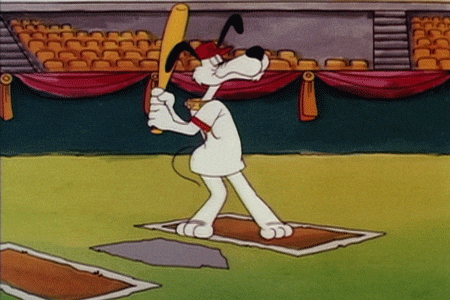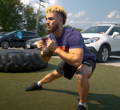Best 4 Exercises to Increase Speed for Baseball
Baseball players are notorious for thinking they don’t need to do resistance-based training. They think they can get away with being genetically fast and explosive to a point. They get worried that there is no point in getting into the weight room because they’re going to get too bulky or big, looking like a bodybuilder. These are just false beliefs. These are concepts that are archaic.

Now if we are going to think about training speed for baseball players, we need to look at the actual sport. What do we need to work on if we are working on speed for a center-fielder who needs to track a ball overhead running at full speed--they need to have really solid DTC (dynamic trunk control), be fast, and track that ball down. Think of a short-stop or a third-baseman reacting and diving after a hitter smashes a line-drive to get the out. They have to be extremely fast, able to react quickly and have speed and strength to get out of the position they are in to make the play.
These four exercises will help us track a ball down, react extremely fast, and help as a base runner to have more speed. And that is the final aspect of speed for baseball. Baseball is run on 90-foot baselines. This means when we are running everything is during the acceleration phase. Everything is based on acceleration. Running to first base demands quick acceleration. Cutting and sprinting to second base to hit get that double may happen as well. Still, it is only 90 feet on each line. We are basically never going to get to our top-end speed. So we have to use the best movements to trigger the most enhanced speed production for the demands of the sport.
1. Banded Side Jump
Right off the bat, some people will say this isn’t really an exercise that needs to be done for strength training. That’s right, it is more of a plyometric movement.

We can have the band wrapped around the waist or connected to the chest with the hands. Just make sure the band is anchored to an inanimate object that won’t move. Once the band is connected, we can walk it out and get nice and solid tension. From there we are going to jump and let the band pull us into the opposing leg. When the leg grounds, we want to drive as hard as possible from a unilateral perspective. We want to drive as quickly as possible from that point and drive back across the body, land, and then do it again.
The tension from the band pulling us in will force a very rapid contraction and muscular action from our quad and glute medius, which will help us to cut back out. Being able to repeat the movement will also help us develop better DTC. If we are constantly getting pulled in and collapsing in the chest, we will experience troubles on the field.
Do this movement twice a week for four or five sets of three to five reps on each side.
2. Dumbbell Single-Leg Squat
When we are playing baseball, say on first base and we are trying to steal or a power hitter is at the plate and we need to take off on contact. We are going to be in an acceleration phase. So if we can think of sprint mechanics, we need to understand the concepts track coaches and biomechanists developed around speed. For instance, when exiting first base, we are getting into the drive phase. Those first five steps have to be hard and pushed as rapidly as possible. This means we have extremely strong glutes and quads. That’s where the dumbbell single-leg squat comes into play.

The movement will light up the posterior chain and even target the quads quite a bit. Now the glutes are the biggest muscle on the posterior chain. And if the glutes are strong we can run and accelerate faster. Ideally, the faster we accelerate the easier it is to get to second and third base.
Do this movement once or twice a week for five sets of six to seven reps on each leg.
3. Drop Cossack Squat
This movement will be done with a little bit of a lighter load. We can hold a twenty-pound dumbbell. We can start by getting into a hip lock position and then drop our leg to the outside laterally. As we drop the leg, we want to get into the Cossack squat position and explode out of that deep position, back into the hip lock.


This is a complicated movement. It is a compound movement. There are a lot of things going on. We have to have DTC when we catch the leg in the deep Cossack squat position. Remember, DTC is necessary to help track a ball down--think about keeping the torso steady so the eyes can track the ball properly. We don’t want to be like Gumby in the abs. We need to focus on the trunk is nice, tight, and rigid to allow the body to absorb force more effectively to drive out from a side angle. Driving out of the side angle is great for batting in baseball, playing the in-field in baseball, or pitching.
Build into this movement for a couple of weeks before adding weight. We also recommend starting with just normal Cossack squats before beginning to perform the drop Cossack squat. This exercise will dramatically improve hip mobility, hip structure, and lateral speed. We recommend performing five sets of three to four reps on each side.
4. Power Clean Or Full Clean
Bryce Harper is incredible. He is extremely fast. What does he do in training? He does power cleans! He does full cleans! He is strong as hell. And we still have baseball coaches telling players not to lift weights. Sigh…

When we are training for speed we have to understand that almost all of baseball is reactiveness and explosiveness. We can do rapid power cleans, like five doubles with sixty-second rest. In this scenario, we are training our bodies to coordinate as rapidly as possible and training our bodies to absorb energy very quickly. These are key components behind DTC and will also benefit performance on the field.
Power cleans or full cleans teach us how to utilize our hips more effectively. We also learn how to coordinate muscles synergistically. Lifting heavy weight fast allows us to turn on the ball more effectively, have more speed, and react quicker out in the field. Remember, all of baseball is played in acceleration within the drive phase.
Baseball players can do power cleans or full cleans for five, six, or seven sets of doubles, or four sets of triples. These movements can be performed two to three days a week. One day focus on speed, utilizing power cleans. Another day focus more on strength work and do full cleans. The body will feel drastically faster because the body will learn how to recruit high-threshold motor units at a greater rate which leads to becoming a faster more explosive athlete.
Recap
Stop living in the Stone Age and utilize these four movements to become a better athlete on the diamond today. Become faster, have greater DTC, and drastically improve lateral speed. Best of all, the exercises are geared towards developing reactive speed, acceleration capabilities, and hip utilization, all aspects that create more capable fielders, hitters, and throwers in the sport of baseball. Try the movements out and give us some feedback on which one is the best and why.
DANE MILLER
Dane Miller is the owner and founder of Garage Strength Sports Performance. He works with a select handful of clients on building comprehensive programs for fitness and nutrition. Several times a year he leads a workshop for coaches, trainers, and fitness enthusiasts.


